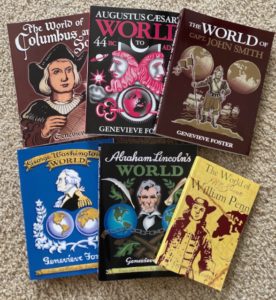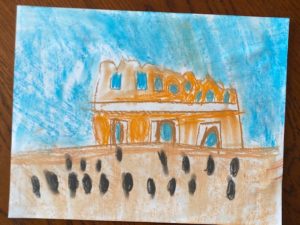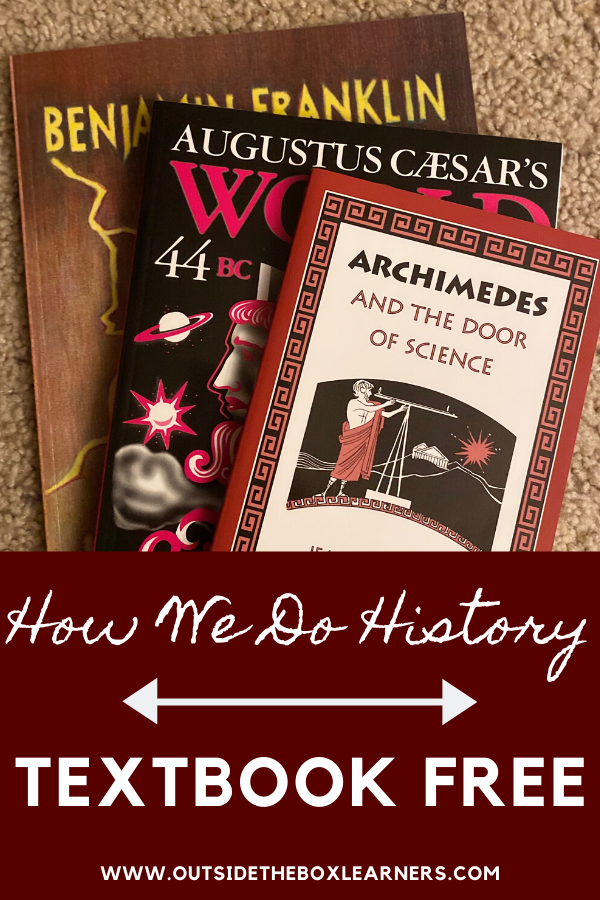If asked as a child what my least favorite subject was, I might have said history. And if I had to describe how I felt about history as a child, I’m sure the words dry, boring, and pointless would have come to mind! (with the exception of the Holocaust which I have always been interested in)
I actually got my only “C” ever in Western Civilizations in college.
The material was just so “foreign” to me (seriously no pun intended!) But truly, though I would PORE over my textbook for the class, the material just would not stick. It was painful. Can you relate?
Fast forward to now. Would you believe history is one of my favorite things to learn about with my kids? Probably because I’m right in there learning with them, for what feels like the first time! If you’ve ever been in a Classical Conversations community, they refer to this as “redeeming your education.”
I personally find textbooks dry. Even the best of them. And the homeschool community has some wonderful ones to offer (I’ve not personally used these but have heard great things about them – Notgrass, History Revealed, and Mystery of History come to mind.) Maybe I will use them someday, but for now, we are enjoying not using a curriculum (and we’re learning lots!)
Here’s how we do history – textbook free!

This post contains affiliate links and purchases made through such links will result in a small commission for me (at no extra cost to you.) Thank you for your support.
We Love Living Books
Reading living books together, especially ones that deal with history has ignited a love for history in me. And there are just so many living books to read! If you need book ideas, two of my favorite books for finding living books are Honey For a Child’s Heart and Books Children Love.

![]() Beautiful Feet Books is also a fabulous place to purchase living books. They have them categorized by grade level and time in history, and also author sets. We have a few of their sets and LOVE them. The D’aulaire set is especially a favorite as the illustrations are phenomenal.
Beautiful Feet Books is also a fabulous place to purchase living books. They have them categorized by grade level and time in history, and also author sets. We have a few of their sets and LOVE them. The D’aulaire set is especially a favorite as the illustrations are phenomenal.
We also have Genevieve Foster’s Collection which is JAM-PACKED with historical facts (if you have an information lover!) 
Beautiful Feet Books also offer teacher guides, for parents who want that.
So far I have booklists of living books for history for Ancient Egypt, Ancient Greece, and Ancient Rome.
We Use Interesting Spine Books
Our main “spine” book is a Child’s History of the World. It’s written in an engaging way and helps fill in the gaps (that will inevitably be there) and makes sure we don’t miss any big events of history. We also base our butcher paper timeline on dates from this book.
I love that all of history is on one giant timeline that the kids have created themselves. (If the idea of a giant roll of butcher paper scares you they make blank timeline books – this one is an example.) It really helps them to see how each event is just a snapshot in the big picture of time. And that history DOES repeat itself.

There’s something about drawing what you’re learning that really makes it stick in your brain! And it’s especially wonderful for picture-smart kids!
We also use Usborne books for a spine. Love Usborne! Our favorites are Time Traveler and The Encyclopedia of World History. 
Incorporating Technology
We’ve been incorporating more technology into our learning this year, especially with history.
Some of our favorite resources include:
- Drive-Thru History
- Game-Ed Academy (Minecraft – my daughter does builds related to history, such as a Cleopatra statue and a Middle Age Manor)
- Chalk Pastel Lessons on History

- Story of the World – I included this with technology since we only use it on audiobook. We love Jim Weiss as a narrator and save this for the car! (hubby loves it too!)
I wish I could say we incorporate tons of amazing activities, but we don’t. We HAVE done that at times(check out these awesome Hands-on Activities for Ancient Egypt), but usually, we stick to what I mentioned above.
Incorporate how your children learn when possible!
Since all children have different strengths/smarts, consider their strengths when deciding how to teach and present material. A picture-smart child would enjoy drawing what they are learning. A body-smart child might enjoy re-enacting a scene from history. A music-smart child might connect to the material by listening to music from that time in history. Etc. etc. You get the idea!
I would be remiss if I did not mention that my kiddos LOVE Horrible Histories. They are a little more “edgy” and filled with tons of facts (that you may or may NOT want to know) but your kids will learn about history from reading them! That can not be disputed. 😉






